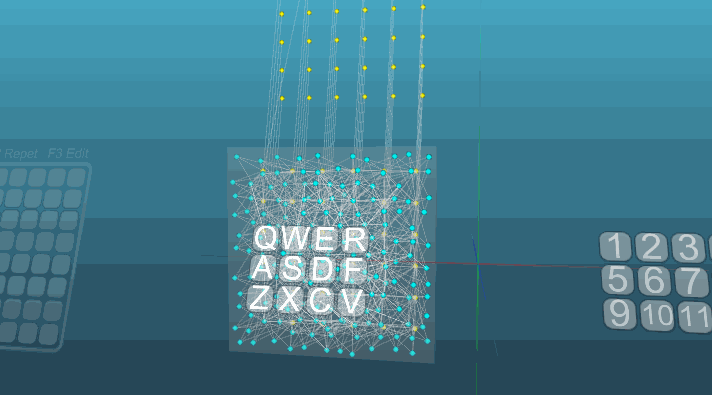The structure and initial settings of the brain
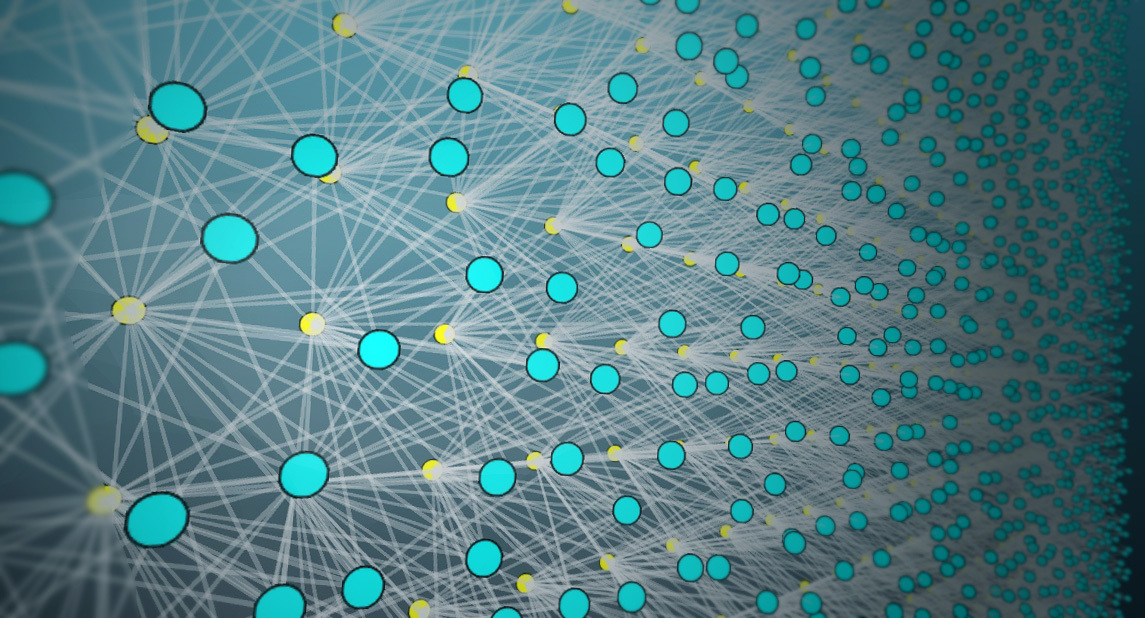
Knowing how a neuron works is not enough to understand what makes sense and intellectual behavior. Evolution has made amazing skill, creating a system of relatively simple elements that can hit incredible success in interaction with the environment. It is not enough to take a certain mass of connected neurons (even folded) to connect sensors and conclusions to it and get at least some semblance of a brain. The main field of evolution over millions of years is not a neuron, but the structure and internal organization of nerve cells in the nervous system.
In the previous part, we talked about the structure of the cerebellar cortex and from his example it is clear that the structure and organization is fundamental to its functions. Let's understand how the bark of the big hemispheres is organized, the structure due to which Man has become the most successful view on Earth.
Table of contents
')
1. Simulator of the nervous system. Part 1. Simple adder
2. Simulator of the nervous system. Part 2. Modulated Neuroelement
3. Simulator of the nervous system. Part 3. Associative Neuroelement
4. Memory, memory consolidation and grandmother's neurons
5. Modeling emotions or electronic sense of novelty
6. Amazing cerebellum
7. Structure and starting brain settings
It is known that the cerebral cortex of the human brain consists of six conditional layers, but it has come to this form over many stages of evolution. Therefore, to begin with, we will consider a simplified version with 2 - 3 layers, because such an option also takes place in nature. It is more profitable to study any biological structure from the standpoint of its evolutionary development. Evolution followed two paths of bark development: an increase in the number of layers and an increase in the total area of the bark.

The second feature of the cortex is the presence of so-called cortical columns. It can be said that the cortical column is a logical unit of the structure of the cortex. The growth of the cortex itself during embryonic development is accomplished by dividing, self-copying of whole columns. And this is logical if we want to maintain a certain structure during growth.
 At the heart of cortical columns are pyramidal neurons. Pyramidal neurons are one of the largest neurons of the nervous system, therefore, the most studied, since their dimensions allow them to be influenced with the help of special electrodes without destroying the cell. These neurons have an advanced dendrite system that spreads throughout the column, as well as an axon, which in some cases is the source of an incoming or outgoing signal. Although there may be several such neurons in the first layers of the cortical column, they all work as one neuroelement. The activity of one pyramidal cell often means the activity of the whole group of cells. The evolutionary development of the nervous system was previously focused on reliability and the duplication or distribution of one functional into groups of cells is a ubiquitous phenomenon. It is impossible to imagine a scheme created by nature, in which the death of just one cell would lead to the disruption of the work of an entire functional unit. It can be said that the activity of a group of pyramidal cells in a column indicates the activity of the column itself.
At the heart of cortical columns are pyramidal neurons. Pyramidal neurons are one of the largest neurons of the nervous system, therefore, the most studied, since their dimensions allow them to be influenced with the help of special electrodes without destroying the cell. These neurons have an advanced dendrite system that spreads throughout the column, as well as an axon, which in some cases is the source of an incoming or outgoing signal. Although there may be several such neurons in the first layers of the cortical column, they all work as one neuroelement. The activity of one pyramidal cell often means the activity of the whole group of cells. The evolutionary development of the nervous system was previously focused on reliability and the duplication or distribution of one functional into groups of cells is a ubiquitous phenomenon. It is impossible to imagine a scheme created by nature, in which the death of just one cell would lead to the disruption of the work of an entire functional unit. It can be said that the activity of a group of pyramidal cells in a column indicates the activity of the column itself.Columns can be divided into two types: forming the signal and receiving the signal. The type of the column depends on what axons the pyramidal neurons have: afferent or efferent. If there are afferent axons, that is, those bringing a signal, then the column will be activated when the signal is received, the signal may be retransmitted if there is an efferent axon. In the presence of efferent axons, the result of column activity will be the formation of an outgoing signal.
 The dendrites of the pyramidal neurons stretch to the upper layers of the cortex, where they extend beyond the limits of their cortical column, thus local interaction between adjacent columns is carried out. One form of local interaction is lateral (lateral) inhibition. The braking of neighboring columns is carried out by means of special inhibitory neurons, which are part of the cortical columns. Mainly inhibitory neurons exert their effect on pyramidal neurons, preventing their activation.
The dendrites of the pyramidal neurons stretch to the upper layers of the cortex, where they extend beyond the limits of their cortical column, thus local interaction between adjacent columns is carried out. One form of local interaction is lateral (lateral) inhibition. The braking of neighboring columns is carried out by means of special inhibitory neurons, which are part of the cortical columns. Mainly inhibitory neurons exert their effect on pyramidal neurons, preventing their activation.Lateral inhibition turns on adjacent surrounding columns. It allows you to make the boundaries of the areas of active columns more distinct and the areas of activity more localized. Due to lateral inhibition, there is an obstacle to a strong spread of excitation.
In addition to lateral inhibition, there is also a lateral impulse. By adjusting the balance, between these two factors there is the possibility of very finely adjusting the level of total activity in the brain. For example, for sleep, it is required to reduce the level of activity; for this, it is necessary to strengthen lateral inhibition and weaken the stimulus. This is done through special chemical signals and mediators.

The effect on adjacent columns does not always take the form of a uniform concentric distribution. For the entorhinal cortex, the distribution is peculiar, which makes it possible for the excitation to spread more easily in a certain triangular grid. These are the so-called grid cells, which help animals to orient themselves in space, by further modifying the image of the place of stay.
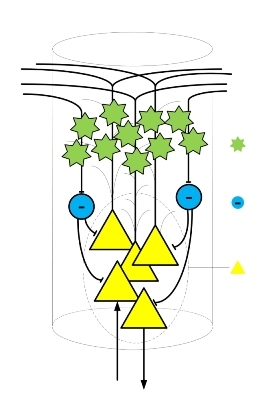 The next element of the cortical column is a layer of many relatively small star-shaped neurons. This layer is usually called granular. Neurons of this layer are less studied than pyramidal neurons due to their size. It is the neurons of this layer that can be assigned the main role in the computational processes of the brain, thanks to their work the formation of associative connections and the formation of images take place. "Calculations" occur according to the principles of mutual excitation. The neurons of the granular layer is an associative neuroelement . And the pyramidal cells play the role of a simple adder , these elements are separated, as it were, and images are isolated. Pyramidal neurons will be activated when a significant part of the neurons of the granular layer of the column is excited.
The next element of the cortical column is a layer of many relatively small star-shaped neurons. This layer is usually called granular. Neurons of this layer are less studied than pyramidal neurons due to their size. It is the neurons of this layer that can be assigned the main role in the computational processes of the brain, thanks to their work the formation of associative connections and the formation of images take place. "Calculations" occur according to the principles of mutual excitation. The neurons of the granular layer is an associative neuroelement . And the pyramidal cells play the role of a simple adder , these elements are separated, as it were, and images are isolated. Pyramidal neurons will be activated when a significant part of the neurons of the granular layer of the column is excited.The connections between the star neurons can freely go beyond the boundaries of their cortical columns, one can say that the granular layer is almost solid.
Memory, memory consolidation and grandmother's neurons
Such a variant of the cortical column and the structure of the cortex is very simple and may even seem primitive, but if it is used on a large scale and properly configured, a structure with high computational parameters can be obtained. Nature has always chosen the most simple, reliable and effective solutions, and our nervous system is not an exception to this rule. Often I come across the opinion that a neuron is like a supercomputer or a quantum computer that makes complex calculations using certain oscillations of ions on its membrane or quantum mechanisms. Even the summation algorithm in neurons of a normal perceptron is more complex than in a biological analogue, in a perceptron it matters from which synapse signals come from, and in a biological one, only the total sum of the effects is important. Stereotypical thinking about the unattainable complexity of the brain can impede an understanding of the nature of a biological system.
Surprisingly, the described structure is universal for various types of areas of the cortex: sensory, motor and associative. Variations in the relative thickness of different layers are possible, depending on the function of the cortex area. For example, in the motor cortex, the layer of pyramidal neurons is enlarged in relation to the granular layer, because the signals of the motor cortex must be clear and strong. And for associative regions, an enlarged layer of stellate neurons is characteristic, in order to provide the greatest flexibility in the formation of associative reflex arcs.
The areas of the cortex are intertwined with a multitude of connections, this is due to the axons, the long processes of neurons. Axon bundles form nerves, which is the so-called white matter. These nerves can connect both neighboring areas and areas of the opposite halves of the brain. Moreover, the architecture of these connections is due to the evolutionary development of the brain and partially acquired experience and learning, but for different people the picture of these connections will be similar. There are several research projects related to the mapping of these links, for example, the Human Connectom Project .

Let's look at how the data links are organized.

The presented scheme is only an example for understanding the principles of organization. Real schemes in the biological nervous system are many times more complicated.
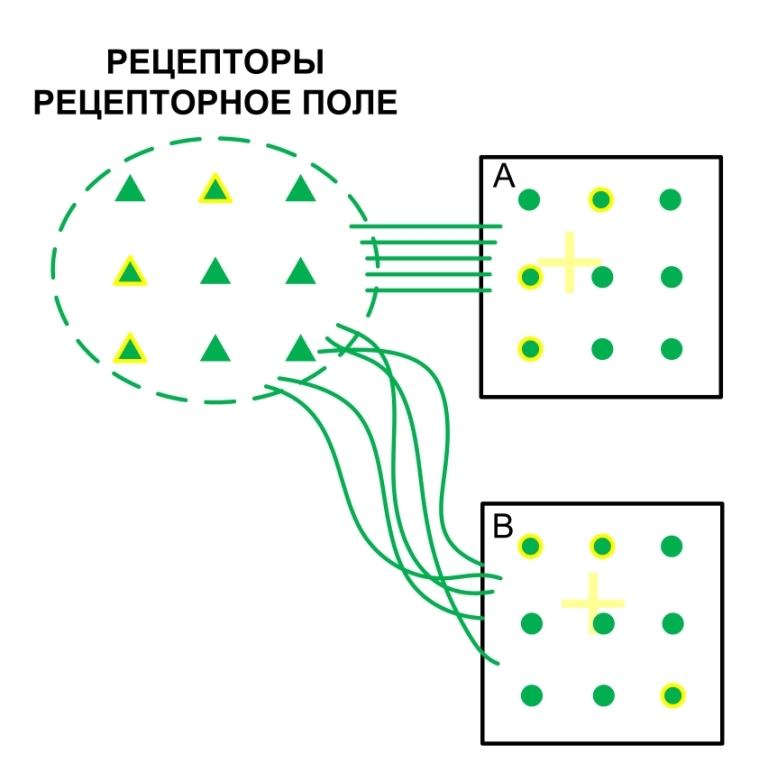
Imagine some receptor field with a number of receptors of the same type, which allow to get some information about the environment. Certain receptor fields form combined signals, for example, the retina of the eye. Such signals require specific analysis capabilities. Representative columns of these receptors will be distributed over the sensory cortex with a certain density while maintaining the topology of the location of receptors in the receptor field (A). According to the principles of mutual attraction of excitation, certain areas of excitation will form on the cortex, which will be the image of the incoming combined signal. The primary sensory cortex usually has the highest possible neuroplasticity, i.e. any combination of excited speakers will be processed without taking into account previously received information. The resulting image will be read by other columns, also with a certain density distributed over the sensory cortex. These columns will transmit information for further processing to the following areas of the cortex. The nature and density of the “reading” columns give a certain filter for the images obtained. It is not difficult to understand that such a processing method leads to a significant loss of information obtained from receptors, the resulting images do not give unambiguous information which particular receptors were activated. Evolution selected two ways to eliminate this problem. Firstly, this is an excessive amount of receptors that compensate for the drop in information content after processing. Secondly, if you duplicate information from receptors in another area, but with violation of the topology of the location of the representative columns in relation to the location of receptors in the receptor field (B), i.e. confuse them. Then with many different combinations of receptor activity in two areas, various combinations of images will be formed, which gives more information and more signs that we can highlight. Naturally, it should be understood that “confusing” signals occurs in a strictly defined manner, for example, if “confusing” the entire field of the retina of the eye does not give any benefit. The confusion occurs in small fragments of receptor fields. And of course we can, if it is required to duplicate and confuse signals more than once. In the nervous system, an example of this separation is the dorsal and ventral ways of processing the visual signal.


The general principle of information processing by the cerebral cortex is the sequential transfer of information from one region to another with a decrease in the density of connections. Moreover, with each subsequent level, the neuroplasticity of the regions decreases, which adds to the calculations the memory and experience of processing the preceding information. Thereby, some key features can be distinguished from the processed information that will be associated with specific nerve cells. Simply speaking, the form of the excitation distribution that corresponds to the most frequent form of the processed signal will be formed on areas of the cortex with a higher level of processing.

The formed image “abc” with a combination of columns a, b and c with frequent repetition or emotional reinforcement will be carried out in the future, even if the activated combination is incomplete and noisy.
At each level of information processing, a certain time is spent, if it is necessary to analyze the dynamics of information changes over time, then it is possible to duplicate a part of information from each level to one area. An analogue in biology is the area of processing of visual information MT (V5), the mid-temporal cortex in which information is collected from areas V1, V2, V3 ..., this area is responsible for the perception of movement. When this area is damaged, akinetopsia occurs - an inability to perceive movement.

Associative areas are arranged relatively simply, there are representative offices of various sensory and motor areas. Moreover, for motor missions, it is important to have bilateral ties, either axons that can work in both directions, or they are adjacent and jointly working columns at both ends, or two axons of the same column, working in different directions. There should be a lot of such areas with different character of location of representative offices so that the possibility of the formation of reflex arcs for various combinations is equally possible. In such areas, conditioned reflexes are formed, so these areas should have a low ductility.
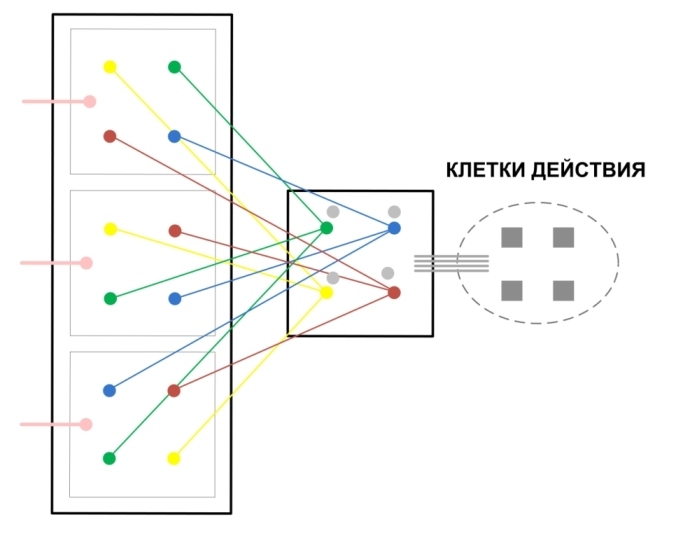
All connections in the motor and primotor areas should be bilateral, it is necessary for the formation of associative links. Essentially, the primotorny region should form reflex arcs of sequences, from one source of excitation to another. In order for more variability to be necessary, representations leading to actions to be mixed up repeatedly, this is similar to the situation with sensory processing only in the reverse order. Also, all motor actions interact with a specially arranged area of the coordinating action in time - the cerebellum.
The presented schemes are a strong simplification of how it is tripled in the brain, and the creation of logical structures similar to the human nervous system is impossible without the participation of specialists in the field of neurobiology and scientists studying a connection.
But what about the other layers ?! - Indeed, I told only about three layers of bark, but in the human brain there are six layers in the cortex of the big hemispheres. The cerebral cortex was a fairly successful product of evolution, even with a small number of layers. The principle of evolution: what works - do not touch. Therefore, an all new layer in the crust is a superstructure to the existing layers. If you look at the layers of the human brain, you can see that we have not six visible layers, but two logical layers whose structure is similar and repeats. Evolution simply repeated the existing structure in order to increase productivity.
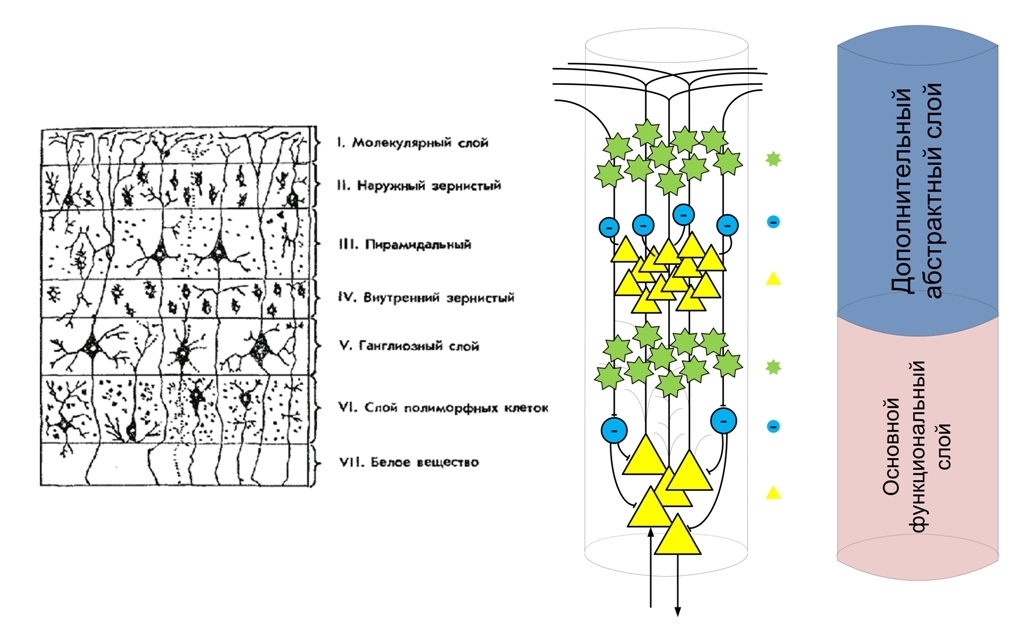
The pyramidal cells of the outer layer are smaller than the pyramidal cells of the first layer, which means they generally have a higher threshold of sensitivity to activating factors. The granular layers will work under similar conditions, but presumably the stellate neurons of the outer layer have a lower plasticity, which means that under certain conditions the patterns of activity in the granular layers may differ, despite the fact that the incoming signals will be the same.
Thanks to these two logical layers, there are two modes of cortical column activity. First: the full activity mode, the code of the pyramidal cells of both layers are activated, the whole column is activated. Second: partial activity mode, when only the top additional layer is activated. These two modes of the column can be compared with a person's ability to speak in full voice and in a whisper, a whisper is a partial activity, and a full voice is a full activity.
What does this give? For sensory cortex, this is an additional level of information processing, as well as the ability to work with images of these areas without activation through receptors. In other words gives the opportunity to work with fantasy. For associative areas, this is an additional level of abstraction, the formation of associations between images with fewer common features, since the threshold of sensitivity of pyramidal cells of an additional layer is higher. For the motor and primotor cortex, it is an opportunity to work out some movements without directly performing them. Only with full activation of the column, actions occur, actions with partial activation remain in our imagination.
Of course, there are areas in the brain that control the work of column modes, just as we can very easily change the nature of our speaking from a whisper to full force. If you increase the level of inhibition in a column, then it is possible that it will only be partially activated, if, on the contrary, you can brake a column, then some thoughts can immediately be translated into actions.
Fantasy and a high level of abstract thinking made man the most successful kind on Earth.
Even if we set up the areas and the connections between them correctly, this will not be enough to get a working model. Necessary unconditioned reflexes. Man is born with a rich set of reflex mechanisms, carefully selected by evolution.
Setting up unconditional reflexes for the model is an important point, given the fact that learning new reflexes is always based on existing reflexes. If any action is not involved in any unconditioned reflex, then it will be impossible to learn how to control this action.
In biological systems, “clear” reflexes are not initially laid. After birth, we cannot precisely control our limbs or, for example, walk. This is due to the fact that it is impossible to determine in advance certain parameters of the body, the size of the limbs, their weight, the force created by the muscles, etc. moreover, these parameters also dynamically change in the process of growth of the organism. Therefore, many unconditioned reflexes have some kind of action field in the response, and in the heading field there are receptors that activate it. It also lays down the emotional mechanism associated with the unconditioned reflexes, which will trigger reflexes to adjust at a certain point in development.
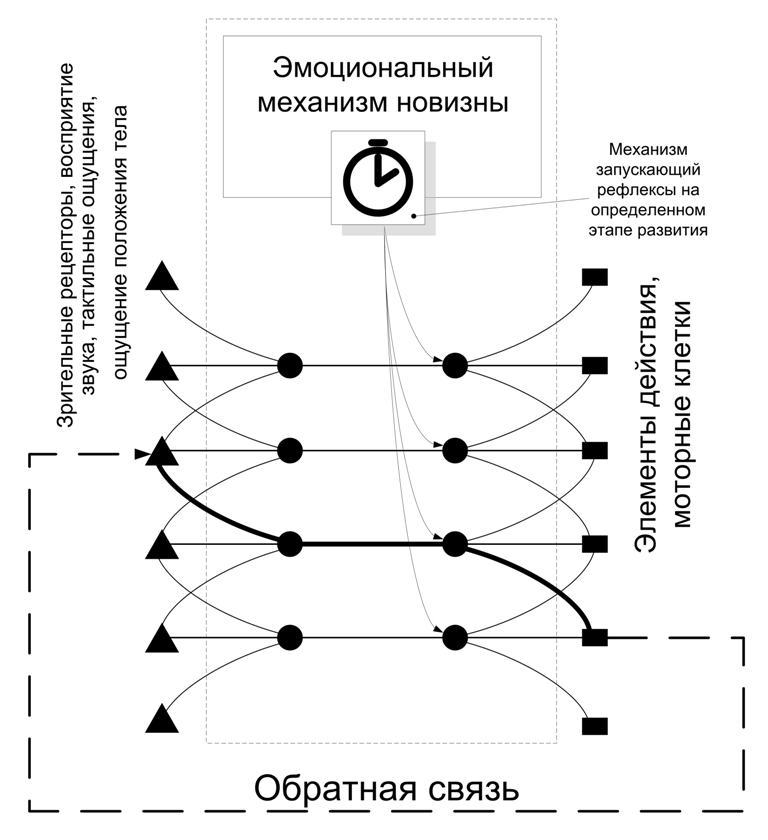
Consider the mechanism for correcting reflexes on the example of baby talk. In accordance with a certain stage of development, the babbling mechanism starts, i.e. there is an almost spontaneous launch of "fuzzy" reflexes. When they start, the child begins to pronounce various sounds, sometimes these same reflexes are provoked by the sound heard from the side. Sounds heard are often not as expected, i.e. do not correspond to the sounds triggering the reflex, or triggering hypothetically. The child hears the sounds he himself produces, receiving feedback between the team and the resulting action. Further, the emotional mechanism of novelty comes in, which connects the center of need for novelty with the speech act, which gives a new association between the audible sound and the inner motive that prompted action. Which leads to repeated repetition of the action leading to saturation of the feeling of novelty. It is alleged that the child in the period of babble pronounces all the sounds of all languages on Earth. The repeated repetition of sounds leads to the formation of clear patterns of action in accordance with the desired result.
Similarly occurs and the mastery of the motor system. Initially, the movements of babies are almost chaotic, there is only an increase in motor activity as a reaction to the emotional stimulus. But over time, a comparison of movements and visual perception, tactile and perception of body position occurs.
Some unconditioned reflexes are not so primitive, in certain cases template images are laid in the nervous system, and it is almost impossible to transfer such patterns from biological systems to a computer model. Man has an innate ability to recognize the emotions and movements of individuals of his own species. Therefore, in some aspects of the training, there will be a need to apply some workarounds.
In order to bypass the process of prolonged learning of the motor system through numerous attempts to crawl, get up, walk and a series of falls, it is possible for the android robots to use the method of intercepting control.
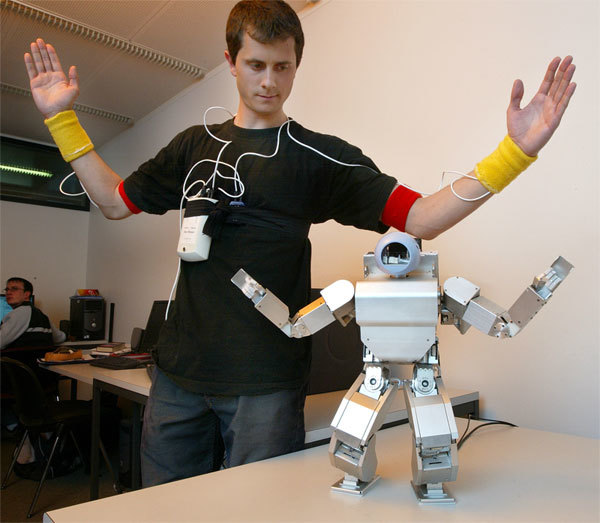
A person can transfer his experience in controlling the body to a robot through special devices and technologies for intercepting movements. In the model of the nervous system of a robot with intercepted control during motor actions, the corresponding representations will be activated, so if these movements were performed by the robot itself. Due to this, the necessary images and associative links would be formed. For example, during training with the team: “Raise your arms” - the teacher in the mode of motion interception raises his hands, this would result in the formation of a conditioned reflex between the team and the action, as well as an associative connection between the team and the image of the position sensors body.
In the process of learning the electronic model of the brain, it is always possible to control the plasticity of the desired areas, as well as have the opportunity to look "inside" the learning process, and select, designate and strengthen the resulting images. That should significantly speed up the learning process of artificial nervous systems in relation to human learning. As has already become clear, a model built according to the principles described will be trained for the most part like a human being, without separating learning and interacting with the environment.
Instead of conclusion
This cycle of articles ends the next stage of research and development. The program, developed for modeling, though limited in its functionality, made it possible to form a theoretical basis for further work. Of course, the obtained theory still needs some work, as well as practical confirmations and tests. But now it will allow a different look at the task of modeling the nervous system. The next step is the development of a new modeling environment, which will create models of larger-scale processes occurring in the nervous system. As well as to embody a number of ideas, observations and theoretical conclusions.
I am not a scientist, and my main activity is not related to the development of intelligent systems, as well as with neurobiology. But I will make every effort to bring the project to its logical conclusion. I will be glad to consider your suggestions, advice and recommendations, as well as constructive criticism. I will definitely tell about the news of the development of the project on the pages of GeekTimes and on your YouTube channel. Thanks to all!
Download Nervous System Simulator for Windows
PS It will be inhuman to put the source code without explanation. Therefore, a link to the source and some explanations of the algorithm and logic lay in a separate article.
Source: https://habr.com/ru/post/397749/
All Articles

